
MAY CONTAIN NUTS

Search Shorpy
SHORPY ART

Framed or unframed, desk size to sofa size, printed by us in Arizona and Alabama since 2007. Explore now.
Join and Share
Ad-Free Shorpy
Shorpy is funded by you. Patreon contributors get an ad-free experience.
Learn more.

Recent comments
- Baldwin 62303
- Baldwin VO-1000
- Cold
- No expense spared
- Tough Guys
- Lost in Toyland
- And without gloves
- If I were a blindfolded time traveler
- Smoke Consumer Also Cooks
- Oh that stove!
- Possibly still there?
- What?!?
- $100 Reward
- Freeze Frame
- Texas Flyer wanted
- Just a Year Too Soon
- WWII -- Replacing men with women at the railroad crossing.
- Yes, Icing
- You kids drive me nuts!
- NOT An Easy Job
- I wonder
- Just add window boxes
- Icing Platform?
- Indiana Harbor Belt abides
- Freezing haze
- Corrections (for those who care)
- C&NW at Nelson
- Fallen Flags
- A dangerous job made worse
- Water Stop
Member Photos
The Shorpy
Print Emporium
Print Emporium
Search Shorpy
Search results -- 30 results per page
- Bicycles, Cadillacs: 1910
- ... New Orleans circa 1910. A close-up of the H.A. Testard Bicycles & Automobiles storefront from the previous post . Detroit ... in those days
motorcycles had more in common with pedal bicycles than not.
What a lovely old car! And it's under repair - the ... Posted by Dave - 04/06/2013 - 11:58am -
![Bicycles, Cadillacs: 1910 New Orleans circa 1910. A close-up of the H.A. Testard Bicycles & Automobiles storefront from the previous post. Detroit Publishing Co. View full size.
And Motorcycles Too!Sure is a motorcycle prominent at the end of the window. I can't
tell what make it is (there were a lot). But, back in those days
motorcycles had more in common with pedal bicycles than not.
What a lovely old car!And it's under repair - the far side of the bonnet (or hood, as it's American) is open. I can't make out a manufacturer's name on the front: does anyone know what kind it is?
[It's a Cadillac. - Dave]
Move along, nothing to see here...Unless you want your SOUL to be EATEN!
Still around.There are some of those cars around today thanks to collectors.It would be great if this car was one of them.
French ConnectionCouldn't help but notice the similarities with this bike shop, still functioning in Montreal.
View Larger Map
Bugs in Your TeethHere's the Cadillac, with optional no windshield, snapped at Hershey, Pennsylvania, October 2009
General Store? Ah yes, autos, bikes and... funnels? I guess fueling up could be quite the adventure in those days.
1910 Indian singleAs far as I can make out the motorcycle is a Indian 1910 single. A current photo of one can be seen in
Classic American Motorcycles by Tod Rafferty. According to the book they sold that year for $215.
(The Gallery, Cars, Trucks, Buses, DPC, Motorcycles, New Orleans)](https://www.shorpy.com/files/images/4a19856a1.thumbnail.jpg)
- Our Little Pony: 1938
- ... slid off, as they often did, but cool.
Dances With Bicycles I thought they only stole horses.
Deep thoughts I can't help ... has kicked me humpbacked.
It's like a Cleveland Bicycles poster 120 years, ago Cleveland Cycles (of Toledo Ohio, bizarrely. ... Posted by Dave - 10/27/2019 - 3:21pm -
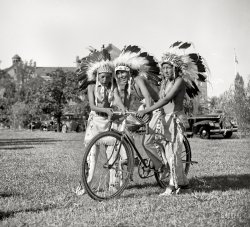
- Ithaca: 1901
- ... like that back in the late 1940s in Florida.
Bicycles I can see at least four bicycles. The 1890's were the "Golden Age of the Bicycle," with the invention ... Posted by Dave - 08/20/2012 - 11:05am -
![Ithaca: 1901 State Street in Ithaca, N.Y., circa 1901. Detroit Publishing Co. View full size.
Far above Cayuga's waterswith her waves of blue
stands our noble alma mater
glorious to view!
Well not yet my alma mater, its quite interesting to see a view of Ithaca, where I'm going to be spending the next four years of my life, from over a century ago. To think Cornell was only 36 years old when this picture was taken! BTW the guy in the beanie was probably an alumnus of Cornell. Ithaca College was a tiny music conservatory until 1931.
Nice perspectiveBeautiful composition. The city before it was cluttered with cars is lovely.
They've Got Moxieand they'd probably sell it to you, too.
Calling all KeystonesAs any silent film fan knows, the window washers, the dog, the well-dressed ladies and the unattended bicycle can only spell trouble. Throw in the barrels, the trolley tracks, plus the horse droppings, and you've got an epic scene on your hands.
Rat Cap!We had to wear freshman beanies like that back in the late 1940s in Florida.
BicyclesI can see at least four bicycles. The 1890's were the "Golden Age of the Bicycle," with the invention of the double-triangle frame and the pneumatic tire both less than 15 years old in 1901.
North TiogaThis appears to be Ithaca Commons looking east toward North Tioga Street from Cayuga Street. Some of the buildings still look the same.
Ithaca CommonsI believe this is the part of State St. that is now the Ithaca Commons, with this view looking east up the hill towards Cornell. If I'm wrong, someone correct me. Awesome photo.
Ithaca CommonsBird's eye view.
"Cars stop here"What about the wagons -- they had the right of way?
["Cars" meant streetcars. It was a "car stop." - Dave]
Behind the TimesI'm surprised that a prosperous Northern city still had horsecars in 1901, many cities electrified their trolleys in the 1890's, if I remember correctly.
I'm curious yellow....That's a scene one doesn't see anymore, a sparrow hittin' on mashed horse apples on the street. Puzzles me however, how to understand the relection of the gent on the bicycle in the window and how it relates to his actual position on the street, an optical illusion of sorts?
BicyclistsWhat a great scene! One doesn't think of 1901 daily life having a lot of bicycling as primary transportation. But just look at
all the bikes on the street!
Comparing photosThis has to be my favorite then and now comparison of the same area. Great work. The popular priced clothiers at P. Rascover have been replaced by the hip sounding Loose Threads, but the mannequins have stayed! The woman on the right with the parasol has a 2009 counterpart in almost the exact same spot, but now with a messenger bag.
Then and NowHere's a picture taken today from as near as I can get to the same spot. The conversion of State Street to the Commons back in the mid-1970's has blocked the long vista down the street, but many of the buildings are still identifiable. Click to enlarge.
[Great photo. Thanks! - Dave]
What's cooking?The "Now You're Cooking" building in the modern photo looks completely different from the building in that spot in the 1901 photo, and - strangely - it looks older. I like the nice curved windows at the top.
Those two guysI don't like either one of those two guys walking on the right
No, not at all.
Foy
Las Vegas
Beer DogCan any Cornelians verify the legend of the dog who lived in one of the frat houses on campus and would ride a streetcar into town by himself every day to drink beer at one of the bars?
My dad, btw, graduated from the university 40 years after this picture was made.
Wide Angle?Seems to be a fairly wide angle shot, without the 'fish eye' type distortion at the edges of the pic. Was there something different about lenses, apertures or cameras then?
[This is the "look" characteristic of just about any large view camera. - Dave]
BicyclesIn addition to the buildings, the bicycles have remained a presence in Ithaca. People bike everywhere, which is somewhat incomprehensible to me in a town that has as many hills as Ithaca. What has not remained the same is the level of dress (although that is true of nearly every locale pictured on Shorpy). Still, if someone wore a suit in Ithaca, they'd probably stop traffic. The type of stores on this street has changed as well. I'm guessing Ithaca Hemp Company would not have been nearly so popular at the turn of the previous century as it is with the hippies that largely make up the town now.
To R-Spice: I hope that you retain that enthusiasm for Cornell after you've been here awhile (and particularly through your first winter). Good luck!
Ithaca StreetcarsIthaca streetcars seem to have been electrified from the outset.
In the year 1887-88 the first track was laid, extending from the Ithaca Hotel to the railroad stations at the foot of State street. On the 1st of May, 1891, the franchises and property of the old company were transferred to the present organization, and on the 1st of June, 1892, the company purchased the franchise and property of the Brush-Swan Electric Light Company, which it still owns. That company had used electricity on the street cars under the unsatisfactory Daft system stem since January 4. 1888. The Brush-Swan system was adopted in 1891.
-- "Landmarks of Tompkins County, New York" by John H. Selkreg, 1894
The Daft system apparently used a low-voltage third-rail power - which had to be a problem in snowy Ithaca. It's possible that Brush-Swan was a battery system, which would explain the lack of overhead wires.
A different perspectiveI took a pic of that same spot as well:
The photo was probably taken with a large-format camera that had perspective controls. It's very hard to do that with a 35mm SLR -- you would need a tilt-shift lens and there aren't any that are really wide enough. I tried to do it by stitching several photos together in Photoshop and adjust perspective, but it's not really very good.
That photo, the old one, is really amazing. It was taken by a professional, to be sure!
(The Gallery, DPC)](https://www.shorpy.com/files/images/4a07685u_0.thumbnail.jpg)
- Bike Shop: 1912
- ... valuable and sought after by collectors. I think music, bicycles, and motorcycles would still make for a fun shop today.
Riddle What do gramophones and bicycles have in common? No, seriously, I want to know.
[Horns. - Dave] ... Posted by Dave - 08/13/2013 - 4:13pm -
![Bike Shop: 1912 Detroit, Michigan, circa 1912. "Metzger bicycle shop. Detroit City Gas Co." This photo of a cycle (and phonograph) shop was taken to show off the gaslight fixtures. 8x10 glass negative, Detroit Publishing Company. View full size.
MotorcyclesI see four motorcycles on the left. An Excelsior Autocycle (Ignaz Schwinn was behind Excelsior motorcycles). Behind the Excelsior is a "camelback" Indian of about 1909 vintage, I think. Then another Indian and perhaps another Excelsior. In today's market those old motorcycles would extremely valuable and sought after by collectors. I think music, bicycles, and motorcycles would still make for a fun shop today.
RiddleWhat do gramophones and bicycles have in common? No, seriously, I want to know.
[Horns. - Dave]
Flash!Is that the reflection of the magnesium flash going off behind the men?
[It is! - Dave]
Huber & MetzgerBill Metzger started the first retail automobile store in Detroit in the old Biddle house. He became the first independent auto dealer in Detroit and probably the US. Below, the Huber & Metzger bike shop at 13 Grand River Avenue.
A hipster's dreamWhat beautiful bikes. As a cyclist, I would love to have one of them.
Just like today's hipster bikesNo brakes - no coaster brakes, no hand brakes.
All the with-it college kids are riding fixed gear bikes with no brakes these days.
Safety third!
FixiesAs far as I can see, none of the bicycles on offer have any brakes whatsoever. Such carefree times.
Well that's puzzlingI don't see any light fixtures that look like gas burners. I'm not aware of any glass bell shades pointing down that were ever used on gas lights. I'm pretty sure I can see bulb sockets on the perimeter lights, although I can't quite make them out. The fixtures in the center of the room have pull-chain switches on them.
[Each gas chandelier has a pair of pulls to regulate flow. Below is another example from Detroit City Gas Co. - Dave]
An Odd MixThe left side of the shop has a good selection of Victor Talking Machines. The right wall has shelves of Edison cylinders . I think I see a Columbia at the back of the shop. And all those bicycles! What a combination.
Mail CallI'd say those envelopes, in the showcases behind the Victrolas, hold recordings by John McCormick, Enrico Caruso, Rosemary Clooney and Elvis.
Early ironSome of those "bikes" are motorcycles.
Not all are bicyclesI spot at least two Indian and two Excelsior Auto Cycles on the left row and can't quite identify what is in back behind the two men sitting though I suspect another Excelsior.
All NaturalNot single black tire in the shop. Everything is natural rubber.
The sound of bikesI find it quite amusing that the two leading bicycle store chains in Israel, where I live, are called Matzman and Mintz. Something with the "TZ" sound drags people to deal with two wheeled vehicles, apparently!
The 8-track of 1912Those shelved items on the right are music cylinders. Music discs were a growing market in 1912 but looks as if this shop's owner had a lot of inventory to move before he could think about selling discs. (Judging by their loose-looking packaging, I don't think the items in some sort of vertical envelopes on the shelves on the left are discs, although if they are, they're way outnumbered by the cylinders.) Some of the songs of the day: "She Pushed Me Into the Parlour," "Daddy Has a Sweetheart (And Mother Is Her Name)," "Ragtime Cowboy Joe," "When Irish Eyes Are Smiling," "The Sweetheart of Sigma Chi" and Irving Berlin's "Keep Away From the Fellow Who Owns an Automobile."
Used MotorcyclesIt seems that these fellows dealt in used equipment as well, Indian Motorcycles produced the last Camelback gas tank single cylinder machine in 1908 (according to my father, who's the curator of a very large motorcycle museum). The Metzger Bicycle Concern would have a heart attack if they knew what that "old" Indian single was worth today.
[This picture could just as well be from 1908. - Dave]
Metzger Got AroundBill Metzger was also behind the Metz car, which has previously been a Shorpy subject. I learned that from a friend who I had sent this photo to.
Gas and ElectricThe center fixtures are gas, but the perimeter fixtures are electric. Best of both worlds when electric lighting was not necessarily bright or reliable.
Obsolete Stock The items on the left-hand shelf are most likely Victor records. Victor & Edison allowed their dealers to carry both lines, until Edison introduced a disc machine & Victor ordered its dealers to drop Edison.
All of the cylinders appear to be 2 minute records, although Edison introduced the 4 minute "Amberol" cylinder in 1908. Both were about to be discontinued in late 1912, along with open horn machines. The celluloid "Blue Amberol" record and a new line of Amberola (inside horn) cabinet machines were introduced in the Fall of 1912. Dealers were then allowed to discount the 'wax' cylinders, to clear their stocks.
By this time, Edison's consultants said people were "Victrola crazy", while Edison's cylinder business fell disastrously & Columbia quit cylinders altogether.
Bicycles & gramophonesIt's what they don't have in common that matters. Bicycles sell well in warmer months when people are outdoors. Gramophones sell well in colder months when people are indoors. I believe this is Metzger's shop at 351 Woodward and not the one he shared with Huber.
http://www.m-bike.org/blog/2010/12/11/metzger-bicycle-shop-in-1912/
(The Gallery, Bicycles, Detroit Photos, DPC, Motorcycles, Stores & Markets)](https://www.shorpy.com/files/images/4a26689a.thumbnail.jpg)
- Iowa City in the Snow: 1940
- ... Cafe building is in the middle of this shot .
Bicycles, white shirts and ties Come to Utah, we have *plenty* of those. ... view from May of 2023.
(The Gallery, Arthur Rothstein, Bicycles, Cars, Trucks, Buses) ... Posted by Dave - 08/13/2013 - 3:35pm -
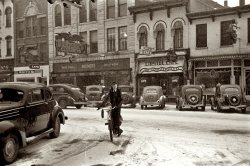
- Al and Joe: 1911
- ... in 20 years that the cities would become impassible. Bicycles, now, that's a much better solution.
Bicycles Of course the drays in these old pictures are hauling freight, not ... Posted by Dave - 07/31/2023 - 7:11pm -
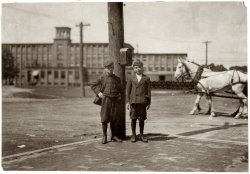
- Wabbit Season: 1910
- Circa 1910. "Rabbit-hunting party of six men, with bicycles, guns and dogs, including rabbits strung between two tents. Possibly ...
Something's Missing I see six men but only five bicycles and five guns. One of them must be a vegan.
Sorry Bugs You ... Posted by Dave - 09/13/2013 - 8:56pm -
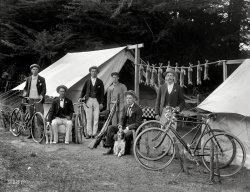
- The Ridgewood: 1904
- ... annex!) From December 1932:
(The Gallery, Bicycles, Cars, Trucks, Buses, DPC, Florida) ... Posted by Dave - 02/18/2024 - 3:46pm -
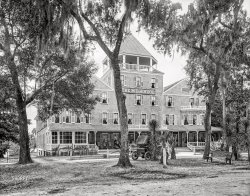
- Montrose Newsies: 1940
- ... country in 1945. People could buy them.
Heavy-Framed Bicycles with Balloon Tires Note that these bicycles have a heavy-duty frame with the top horizontal member doubled ! Not ... Posted by Dave - 09/13/2018 - 12:55pm -
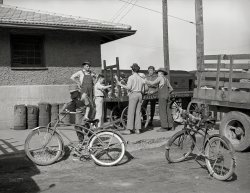
- No Peanuts: 1942
- ... of the exact year or name on the headbadge. Schwinn made bicycles for different companies back then.
Thanks to Dave for the zoom ... space with the meat guy next door?
(The Gallery, Bicycles, Kids, Marjory Collins, Small Towns, Stores & Markets) ... Posted by Dave - 01/30/2024 - 2:25pm -
![No Peanuts: 1942 November 1942. Lititz, Pennsylvania. "Small town in wartime. Peanut stand next to the Lutz butcher shop finds it hard to get peanuts since the war started. Peanut oil is needed in industry." Acetate negative by Marjory Collins for the Office of War Information. View full size.
The Original Educator Crax Cracker ...With the Baked-in-Flavor!
Crax, not CrackerJackCrax crackers, "The Original Educator"
https://clickamericana.com/topics/food-drink/crax-the-most-imitated-crac...
Lutz’s Meat Market ... was founded by B.F. Lutz in 1895 in the rear of 15 East Main Street. The bank drive-thru lanes were the site of a farmer’s market operated by Lutz. In 1927 Lutz’s sons, Ben and John, joined in the business and it was relocated to 53 East Main Street. - lititzlibrary.org
I Spy ... Ms. Marjory CollinsIn reflection to the left right of the "No Peanuts" sign.
A metric wall ??I don't think I've ever seen brickwork before with headers (only) every tenth row (every five or six is the most common).
Crax and a crankWhat be crax, I have to ax. Nineteen cents, at any rate. And that's a doozy of an awning crank there.
"Hygiene" textbookThe New Healthy Living Series: The Habits of Healthy Living, by Winslow and Hahn, 1932.
This is a well-used copy, although it does not sound like the sort of reading that would excite a young teenager.
My New BikeBet that boy is mighty proud of his sleek new bike.
Nations Beyond The SeasThe bigger book on the bike seat is "Nations Beyond the Seas"; can't quite read the spine of the smaller book.
A postwar edition of Nations Beyond The Seas can be borrowed at Archive.org
Watch out ...My bike (c. 1948) has a horn like his. It doesn't require batteries, it blasts out a loud klaxon like sound when the plunger is pushed.
Lovely Prewar BicycleThe bike pictured is a new prewar Schwinn. Not sure of the exact year or name on the headbadge. Schwinn made bicycles for different companies back then.
Thanks to Dave for the zoom into the book spinesReminds me of the movie Blade Runner where Harrison Ford is saying stuff like "Enhance 224 to 176"
[You're very welcome. The zoom is actually from a different photo. - Dave]
"Nutty" SpellingThe numbers on the old piece of wood beneath the peanut window lead me to believe the bags of nuts, when available, would have set you back a nickel, a dime, or two dimes for the large appetite and wallet crowd. Perhaps if they had raised their prices just a fraction they could have afforded another "R"!
Sliver of storefront?That's gotta be the world's narrowest storefront for the peanut guy. No wider than a door opening. Unless it shared space with the meat guy next door?
(The Gallery, Bicycles, Kids, Marjory Collins, Small Towns, Stores & Markets)](https://www.shorpy.com/files/images/SHORPY-8d10178u.thumbnail.jpg)
- Mall Santa: 1957
- ... 60's, starting when I was 6 years old. We'd get on our bicycles in the morning and roam around all day. There was a tunnel under the ... Posted by Dave - 03/05/2024 - 1:28pm -
![Mall Santa: 1957 Circa 1956-57. "Urbanism -- USA. Mid-Island Plaza in Long Island, New York." So where's the Cinnabon? 35mm color transparency, Paul Rudolph Archive. View full size.
Will-o'-the-Wisp"A Will-o’-the-wisp is a phantom light that hovers in the wilderness, luring travelers ..." And shoppers.
ughThat Long Island haze of the mid-20th century. That's the bluest most skies ever got there.
Lerner ShopsI was born in 1957 and I remember even as a kid, enjoying window shopping at Lerner's when out with my mom. And I loved it when I was old enough to shop there for cute outfits with my own money in the '70s. The store was founded by Harold Lane along with Samuel Lerner, uncle of lyricist Alan Jay Lerner.
Timeless Amazing that this photo is 60+ years old, it looks like it could be today. The lack of period cars and clothes makes it timeless.
Santa? Or Satan?That is a horrifying visage.
This reminds me --of those long-ago days when you had to actually go places to get stuff.
It just needs hornsThat Santa would do much better as Krampus.
ArcadeThis early version of the shopping mall – before they were all transformed or built in the covered-over version – makes me think of streets in other countries where they have arcades which provide protection at street level from the weather. It’s pleasant to be outdoors while it’s raining and not need an umbrella.
Also, as someone, like JennyPennifer, who was born in 1957, I always twitch when I see that year.
[Our photo is a visual representation of the definition of "mall" -- an open, unroofed plaza, lined with buildings or trees on either side. - Dave]
Oakridge Shopping Centre: 1959When it opened in Vancouver, B.C., in 1959 Oakridge was not an enclosed mall as it later became. It was anchored by Woodward's Department Store, and was not in an outer suburb. Now the same location is being developed with multiple high-rise residential towers adjacent to a rapid transit station. The 1950s design is remarkably similar to the Long Island mall. Woodward's huge food floor had staff that loaded the groceries into your car for you.
Jericho NativeI lived in West Birchwood in the 60's, starting when I was 6 years old. We'd get on our bicycles in the morning and roam around all day. There was a tunnel under the Northern State Parkway that gave us access to the Cantiague Park and Pool. Often we'd then head over to the Plaza to hang out and grab a slice of Sicilian pizza at Pizza D'Amore. There was a merry-go-round in the northeastern part of the plaza. Then home for dinner.
Two Other ExamplesThis very much reminds me of Glendale Mall in Indianapolis. The mall had been enclosed when I arrived in late 1981, but it retained the Mid-Century Modern ambiance, along with some quirky amenities such as a fountain with moving parts all made of copper, a chandelier made out of many glass tubes, a 20-foot diameter circle on the Terrazzo floor that had the signs of the zodiac on pedestals around the perimeter containing a daily horoscope, and an indoor sidewalk cafe. Today, the center part of Glendale is gone, and the remaining two structures have been "demallified." (Is that a word?)
Before moving to Indy, I lived in Columbus, Ohio. All the 1950s malls had been enclosed except Westland. Even though Westland was on the other side of town from me, I drove clear over there because the enclosed malls (such as my own Northland) were oppressive to me. In the summer of 1981, Westland was enclosed and I stopped going there.
(The Gallery, Kodachromes, Christmas, Stores & Markets)](https://www.shorpy.com/files/images/SHORPY-17152a.thumbnail.jpg)
- Steeplechase for Fun: 1904
- ...
Incomplete What? No "It is to die for?"
Bicycles Checked I wonder what BICYCLES CHECKED means? Is this like a coat check, where you leave your ... Posted by Dave - 05/17/2014 - 10:43pm -
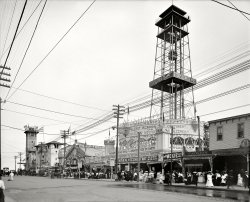
- Detroit Opera House: 1900
- ... S. Glover, Detroit Publishing Co. View full size.
Bicycles!!! I'm impressed by the prevalence of bicycles in this date and time. It makes sense, now that I think about it. ... Posted by Dave - 08/14/2012 - 12:33pm -
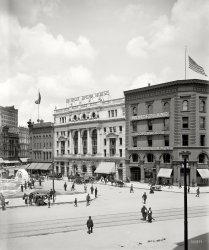
- Eastman Kodak: 1905
- ... one in the old Rocky and Bullwinkle Show.
Notice the bicycles No locks! I reiterate, NO LOCKS!
Kodak is alive and well A ... Posted by Dave - 08/14/2012 - 11:55am -
![Eastman Kodak: 1905 Circa 1905. "Eastman Kodak Co., State Street factory and main office. Rochester, New York." Future home of the late lamented Kodachrome. 8x10 inch dry plate glass negative, Detroit Publishing Company. View full size.
Love OrnateSomeone please tell mt that the wonderful little building next door (that housed the moving company) is still standing. If you look closely, you can see a person going into the store. Also, the street cleaner bucket on wheels looks just like the one in the old Rocky and Bullwinkle Show.
Notice the bicyclesNo locks! I reiterate, NO LOCKS!
Kodak is alive and wellA year ago I went out to Kodak in Rochester for training on their computer to plate and workflow systems. I assure you there is still a huge number of Kodak employees in Rochester. The George Eastman house was an experience of a lifetime. I want to go back and experience the world's largest collection of photographic images.
In the wagon:Barrels of Dektol and D-76.
Good Ole FredHe'll take anything you have and move it or store it for you. I'm guessing he has a bigger building elsewhere!
Human ResourcesThis past summer I struck up a conversation with another diner in a restaurant. He was from Rochester, so the conversation drifted to Eastman Kodak. He asked me to guess how many employees Kodak had that were still in Rochester, I said 100. His answer, six. I thought about it later and couldn't figure out what those 6 people were doing. Licensing the Kodak name? Administering the pension system? Anybody know?
[Eastman Kodak has over 20,000 employees and annual revenues of around $8 billion. Its headquarters are still in Rochester, so I'd bet that more than six people work there! - Dave]
I think you're right Dave, I just went on their Website and they appear to have about 20 Job openings in Rochester.
A Kodak momentThis picture wipes me out. The plainness of the buildings is their beauty. A few modes of transportation going on, except for a car. A trolley, bicycle, horse and wagon/carriage. I wonder if people named their horses back then. Notice the man looking out the window, 4th floor, right building. I wonder what he was thinking about.
DetailsI like the human details in these photos. The fellow leaning out the window. The bikes left at the curb.
RIP KodachromeI assume that Shorpy readers will have heard the news that Dwayne's Photos, the sole remaining Kodachrome processor, used up the last batch of chemicals produced by Kodak just before Dec 31, 2010 to process all remaining submissions of Kodachrome. Now I'll never know what's on the half-roll of Super-8 stuck in my camera when the motor jammed 35 years ago.
All of it goneI checked google street view, and I don't see any of the buildings from this picture. Is it fair to assume all of it is lost?
Love the picture though!
Kodak in Rochester todayI've lived in Rochester my entire life and remember Kodak in when it was the largest employer in the city. According to an article in the Rochester Business Journal Kodak now employs about 7400 people in the area.
Sadly these buildings are long gone and the location is now a parking lot for Kodak Tower which was built around 1913. This photo is looking south down State Street at Platt Street.
View Larger Map
kodak is a disgracewhat you fail to realize is that kodak used to employe over 60,000 people in rochester, now they employe less than 4000, most of which are in management positions. my father was a 3rd generation kodak worker who was recently laid off after 35 years of faithful service. that company was his life and they hung him out to dry. those 20,000 are mostly in mexico, since kodak china went belly up, and those job openings are all temp. jobs. kodak wants to keep downsizing until they can sell the kodak name to someone like fuji, who is the biggest film and imaging business. george eastman would be ashamed of what his empire has become.
[What nonsense. George Eastman was intelligent man and a believer in scientific progress, so he'd hardly be surprised (much less "ashamed") that his business would encounter difficulties once its main product became obsolete. Corporations don't last forever; most are lucky to number their years in decades. This one has lasted a more than a century -- a long and distinguished history. - Dave]
Kodak momentWonderful photo. I work at Kodak's State Street facility as a contractor. I'm very interested in local history and specifically the history of Kodak and its buildings. In my job I get to access parts of the Kodak facility which most people don't see and although a lot of the historic aspects are gone, details still remain and to an amateur historian it's wonderful to be able to walk the halls where history was made. To clear up the employment question, there are currently around 7600 direct hire employees at Kodak in the Rochester facilities plus many hundreds more contract workers. This photo shows the State Street frontage prior to the construction of the iconic Tower in 1912, which would be seen in more recent photos rising behind the far left side of the six story building in the foreground. All have now been replaced by more modern structures (the last constructed around 1948). It's sad to see the buildings which have been lost to time, but Kodak had to be progressive and modern and as buildings became outdated and even structurally unsound, they had no choice but to rebuild.
(The Gallery, DPC, Rochester)](https://www.shorpy.com/files/images/4a23082a.thumbnail.jpg)
- Return Trip: 1901
- ... check it out here .
The Age of Steam, Hats, and Bicycles This delightful photo illustrates three trends which have passed ... "Alexander Hamilton" in my boyhood.
(The Gallery, Bicycles, Boats & Bridges, Detroit Photos, DPC) ... Posted by Dave - 02/02/2015 - 12:34pm -
![Return Trip: 1901 Circa 1901. "Excursion steamers Tashmoo and Idlewild at wharves." At least our third look at these day-trippers tied up at the Detroit River wharf, in a sort of Shorpy version of "Groundhog Day." 8x10 inch glass negative. View full size.
Boaters on their heads - Ships in the riverI would say that 1901 is a little too early for this image.
The ship heading upbound in the background appears to be the Columbia that was built in 1902 and made day-trips to Bob-lo Island Amusement Park in the middle of the Detroit River.
[The negative bears a copyright date of 1901 and was exposed in 1900 or 1901. The ship in the background is the City of Cleveland, launched 1886. - Dave]
As usualAnother Tashmoo picture, bursting with vitality.
I wonder if Tashmootranslates as Floating Sardine Can.
Safety Codes?That ship looks seriously overcrowded. Granted this was two years before the Titanic, but even so, as far as I can see there are just four(!) lifeboats for all those people. And if the Titanic has not yet gone down at least they should remember the General Slocum from just six years previously.
Color me nervous.
On the upside, lots of really sharply dressed people in an age when people actually cared about their appearance when in public.
Correction: I misread the date and thought it was 1910. Hence the odd references to events that have not yet occurred. A/O
No barefeet in Tashmoo ParkFor a quick read on what all the hustle and bustle is about check it out here.
The Age of Steam, Hats, and BicyclesThis delightful photo illustrates three trends which have passed into history.
The "Idlewild" has a clearly visible "walking beam" just aft of her stack. This is part of an old-fashioned (usually) single-cylinder steam side-wheel engine.
See the lines of horse-drawn coal wagons waiting on the wharf to the right of the "Idlewild." A lot of human and equine labor will be expended to get that coal into the ship's bunkers. Compare that with pumping fuel into a modern ship, which requires little human effort.
Everybody has a hat! Some of them look pretty expensive.
1901 would seem to be toward the end of the golden age of bicycling, but certainly there are many in view. They are fairly modern-looking; I cannot spot any of the early Penny Farthing type with the huge front wheel.
All-in-all, yet another delightful Shorpy discovery, one that reminds me of riding the oil-fired Hudson River Day Line side-wheeler "Alexander Hamilton" in my boyhood.
(The Gallery, Bicycles, Boats & Bridges, Detroit Photos, DPC)](https://www.shorpy.com/files/images/SHORPY-4a22147a.thumbnail.jpg)
- American Ice: 1906
- ... U.S. Grant right. More here . -tterrace]
From Bicycles To Automobiles A very detailed description of the buildings and ... Club. Their story and the transformation from bicycles to automobiles is below:
... Posted by Dave - 06/05/2017 - 2:23pm -
![American Ice: 1906 New York circa 1906. "Union League Club, Brooklyn." Our title comes from the delivery wagon on the right. Also note the Ford dealership with the illuminated AUTOMOBILES sign on the roof. 8x10 inch glass negative. View full size.
A survivor, but not the Ford dealer.
"Let me check with my manager about that undercoating."Here's what would have been sitting on the Ford dealership showroom floor next door -- Henry Ford's 1906 Model N. Luxurious touring indeed.
Faces in stoneWonder who those guys are immortalized in sculpture over the arches?
Guy on the left looks like Andrew Carnegie, on the right maybe U.S. Grant.
[Abraham Lincoln left, U.S. Grant right. More here. -tterrace]
From Bicycles To AutomobilesA very detailed description of the buildings and members is at (building description pages 863-4 and members 865-888):
https://babel.hathitrust.org/cgi/pt?id=umn.31951p01018522v;view=1up;seq=...
Grant Square became somewhat of an automobile dealers “colony” as described in the upper left of the below page 211 of Automobile Topics for April 29, 1905:
https://babel.hathitrust.org/cgi/pt?id=nyp.33433089968139;view=1up;seq=2...
The Union League Automobile Company was the name of the dealership adjacent to the Union League Club, occupying the former Kings County Wheelmen’s Club. Their story and the transformation from bicycles to automobiles is below:
http://www.brownstoner.com/history/past-and-present-the-great-kings-coun...
This building was a lot more fun when it had all the cool stuff happening on the roof.
Could it be?My great grandfather was on the board of this club in Brooklyn; they presented the family with a rather elaborate testimony in a leather-bound, gold leafed tome with illuminated calligraphy upon his death; could that be him in the window? The timing is right.
(The Gallery, Cars, Trucks, Buses, DPC, NYC)](https://www.shorpy.com/files/images/SHORPY-4a13306a.thumbnail.jpg)
- Saplings: 1925
- ... Sam the Minstrel Team tin windup...
(The Gallery, Bicycles, Christmas, D.C., Kids, Natl Photo) ... Posted by Dave - 12/22/2023 - 7:52pm -
![Saplings: 1925 December 1925. Washington, D.C. "W.W. Lodding (tree & son)." Scion of Walter W. Lodding, of Office Xmas Party fame. 4x5 inch glass negative, National Photo Company. View full size.
Fatherland ExpressThat little 0-gauge clockwork train has already covered quite a distance -- all the way from Germany, to be precise. It's been made by Bing, a major German toymaker back then. It's not completely surprising that Mr. Lodding decided to buy a Bing train instead of one manufactured by Lionel, Ives or American Flyer -- after all, Lodding is a German name.
Not far from the tree, in two sensesThis charming boy is growing up to look just like his father.
The boy’s futureI wonder what the future held for this boy? I’m guessing his direction may have changed 16 years after this photo was taken. We’ll probably never know, but it’s interesting to reflect.
[More like 15 years. - Dave]
Formidable-looking Dad ... ... darling little boy. That sweet smile warms my heart. Now I want to know how his life unfolded.
Happy Holidays, Shorpsters!
The Ears Ahead.Toys now -- he was 3 here (but like his father, looked older) -- girls later.
In between (1943) was the WWII service wondered about (below). He became a Mason, and -- in contrast to his peripatetic childhood (New York, DC, Atlanta, Chicago) -- seems to have spent the rest of his life in Illinois.(He died in 1982, outliving his mother by just nine years).
Ham and Sam on HandBehind the trike's left wheel I think I spy Ham & Sam the Minstrel Team tin windup...
(The Gallery, Bicycles, Christmas, D.C., Kids, Natl Photo)](https://www.shorpy.com/files/images/SHORPY-15356u.thumbnail.jpg)
- White Castle: 1910
- ... the Detroit public? Can we get a zoom-in Dave?
Curbed bicycles wouldn't last long if parked that way today, and one is right next ... Posted by Dave - 10/17/2013 - 11:44am -
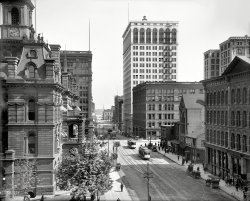
- Hanan Shoes: 1905
- ... the Tailor A print ad for A.L. Sailor
Rambler Bicycles, next door to Hanan Shoes Forerunner of the Rambler automobile, its ... Posted by Dave - 01/14/2014 - 12:40pm -
![Hanan Shoes: 1905 Circa 1905. "Wood Street, Pittsburg, Pa." Home to Hanan Shoes. 8x10 inch dry plate glass negative, Detroit Publishing Company. View full size.
Downtown Style Two very nice examples of circular fire escapes.
Limited "road apples".
Straw hats and bowlers with dark suits for the men, cinch corsets, full length skirts with large decorated Edwardian hats for the women.
A very stylish and clean downtown. Maybe a weekend afternoon.
Much has changedTall white building on the right is still there but updated. Nothing else seems the same.
View Larger Map
+106Below is the same view from July of 2011.
Sailor the TailorA print ad for A.L. Sailor
Rambler Bicycles, next door to Hanan ShoesForerunner of the Rambler automobile, its manufacturer sold the cycle business in 1900 and entered the nascent motorcar industry. Eventually acquired by Nash Motors and its successor American Motors, the Rambler ended its run in the U.S. in 1969. The name lived on in some foreign markets before disappearing in 1983.
Precursor to tragedy?I am intrigued by the man crossing in front of the streetcar. Visual evidence indicates that the vehicle is moving toward him (car's shadow is in the intersection, the trolley pole looks like the car is moving toward the camera). He's just beginning to cross the streetcar's path yet no one seems to be concerned. Am I missing something?
[The man is not as close to the streetcar as it seems due to the apparent spatial compression that occurs when distant objects directly ahead are magnified, either in reality, as with binoculars, or enlarged in a photograph. -tterrace]
(The Gallery, DPC, Pittsburgh, Stores & Markets, Streetcars)](https://www.shorpy.com/files/images/SHORPY_4a12731a.thumbnail.jpg)
- Detroit Rubber Works: 1908
- ... Detroit Publishing Company. View full size.
From Bicycles to Brownfields to "The Bus" Farsighted Fred Morgan and ... Posted by Dave - 09/04/2021 - 10:41am -
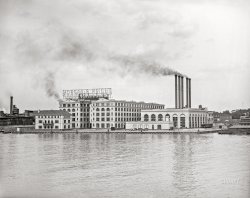
- Tires Half Off: 1920
- ... went belly-up as a result.
I'd love to see the bicycles those went on Oh, wait, those are car tires!
From what I can ... Posted by Dave - 08/07/2012 - 10:27pm -
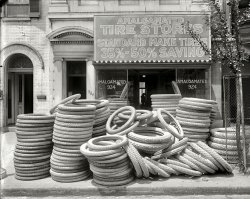
- Bricks and Mortar: 1901
- ... 8x10 inch glass negative. View full size.
No Bicycles I'm sure that with the state of roads back in 1901, the railroads ... Posted by Dave - 10/20/2012 - 10:56am -
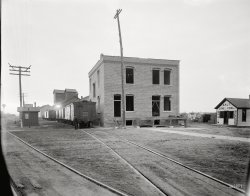
- Parting Glances: 1920
- ... that would have to go all the way up.
Messengers Bicycles, a motorcycle and a messenger office. Pure chance, or a cunning ... shows no evidence of brakes, coaster or hand. When did bicycles begin to have braking systems (other than putting your feet ... replaced in 1925 by the 350cc Model F.
(The Gallery, Bicycles, D.C., Motorcycles, Natl Photo, Stores & Markets) ... Posted by Dave - 08/13/2023 - 3:25pm -
![Parting Glances: 1920 Washington, D.C., circa 1920. "729 12th St., Washington Times." Various shades of Twelfth Street. 8x6 inch glass negative, National Photo Company Collection. View full size.
Wall BetweenI would hazard a guess that there is a wall between the woman and young boy. If you follow the line between "painted" and "unpainted" you will see that the width between the windows is farther apart. Also the chimney above, and the two stores below suggest some sort of support wall that would have to go all the way up.
MessengersBicycles, a motorcycle and a messenger office. Pure chance, or a cunning business plan?
Cleveland MotorcycleThat's a production motorcycle from the Cleveland Motorcycle Co.
Questions indeedIs that young blurry boy only wearing one roller skate? Is the other young child telling the headless phantom motorcycle rider to shush?
Must say I love the "lace" and tassels on the Shade shop.
Possible SlumlordAndrew Murray the builder doesn't take very good care of his property.
Window on my WorldBuster Brown in the window above the deli seems to be looking at the motorcycle. Wondering if he is related to the woman in the window next to him, or if there is a wall between them and they are in different apartments.
So many questions, so little timeAre the shutters seen on some of the buildings actually used? Or are they just decorative as are modern shutters are?
Why don't the brick stone buildings have shutters?
Is that some sort of prototype motorcycle?
Are the people in the windows family members of the proprietors of the businesses below?
Is the boy in front of the messenger service an employee?
BTW, I just love photos like this; an honest and unfettered look into a past long gone.
Ahead of the timesLike the bike propped against the building. Owner has his bars flipped and his seat laid back -- cutting edge!
Tri-LevelWhat a mesmerizing photo; one can conjure up at least three scenarios that fit what we see here. The pride of the gentleman inside the Builder's office watching his son leave; the parting of two friends (or lovers); is the rider embarking on a grand adventure; who is the rider, really? The more you look the deeper the stories become. Olde photos are magic.
Ghost RiderTenants checking out the ghost on the motorcyle seems to be the most likely scenario.
The Phantom PhootSo what's that disembodied upside-down foot above the third floor windows of #731?
Taken for a ride in another senseI suspect that the owner of 729 hired the same Washington housepainter that I did.
Bicycle BrakesThe bike leaning against the Murray/McGregor office shows no evidence of brakes, coaster or hand. When did bicycles begin to have braking systems (other than putting your feet down)?....some Shorpyite out there knows.....
King Cola, the Royal DrinkNot much you can find about this brand, except that it was sued to death by the Coca-Cola Company for its use of the word "cola." How did Pepsi ever survive the same predicament?
[The defendant's sin was not the use of the word "cola" but rather its Spencerian-script logo (below), which was a frank imitation of the Coca-Cola trademark. Coca-Cola's legal blitzkrieg also took aim at Koke, Cold-Cola, Koca-Nola and Ko-Kola. - Dave]
Dividing lineI love that only half of the building has been freshly painted. The other half - the builder's half does not instill confidence in his work.
Looks like the kid on one roller skate leaped from his ghost position to where he is now.
Boys and bikesYou can tell by his blurry foot that the driver is kickstarting his bike. This is an activity that always attracts kids. There's something irresistible about the roar of the engine. The little boy standing behind the bike is thinking, "Someday I'm gonna get me one of those..." I've seen this happen a million times.
My Side versus Your SideIt is pretty clear that the owners of 729 and 731 have a different philosophy of exterior maintenance. What a geometrically precise paint line between them.
One SkateI bet the other roller skate is on the ghost of a kid spinning just on front of the steps. The rider is a blur because he's trying to kick start the bike. Upstairs grumpy, and the two men are much more interested in the photographer.
These are really neat old photos, I'm glad I found the web site.
Honesty of Purpose
Washington Post, April 8, 1911.
Special Notices
Announcement.
The family of the late John McGregor, builder, of 729 Twelfth street northwest, desire to inform the public that the business will be carried on by his successor, Mr. Andrew Murray, who has been with Mr. McGregor for the past thirteen years. They trust that the same patronage extended to the late Mr. McGregror will continue to be shown to Mr. Murray. In reference to the above, I hope, by strict attention to business and the same honesty of purpose that characterized Mr. McGregror's work, to merit the confidence and patronage of his friends and the public generally. Respectfully,
Andrew Murray,
729 Twelfth street northwest.
Shannon & LuchsHoly cow! The Shannon & Luchs For Sale sign on 731 caught my eye. They were the dominant real estate company in Fairfax County, Virginia, when I was growing up there in the 1980s and '90s. I still remember their radio jingle: "It takes more than luck / it takes Shannon & Luchs." I had no idea they had this long a history. They seem to have been acquired by Polinger in 1993, but I know they were still going by the S&L name at least until the late '90s.
Cleveland motorcycleThe motorcycle in the photo is a Cleveland A2, which was manufactured by the Cleveland Motorcycle Manufacturing Company, located in the Ohio city of the same name between 1915 and 1925. The A2 was powered by a 220cc two-stroke engine mounted transversely in the frame, with a worm drive to power the countershaft sprocket for final chain drive. The shaft exited the two-speed gearbox and extended past the rear downtube to drive the the magneto, hung just forward of the rear wheel.
In 1920 the A2 grew larger, adding footboards, incorporated fuel/oil tank and wider fenders. The weight increased in 1921 with a larger fuel/oil tank and seat and a battery. To offset the additional weight, engine capacity was increased to 270cc. In 1923 a sportier model was offered - the Model E, which featured a battery and electric lights.
Although the Cleveland looked flimsy compared to the big V-twins offered by other US manufacturers, their light weight (68 kg) and moderate power (3.5 bhp and 30 mph top speed) combined for easy riding. The main market of the A2 were students, women and businesses who employed couriers and light delivery riders. The low price ($150) was cheaper than comparative bikes offered by other manufacturers. The A2 was replaced in 1925 by the 350cc Model F.
(The Gallery, Bicycles, D.C., Motorcycles, Natl Photo, Stores & Markets)](https://www.shorpy.com/files/images/SHORPY_28800u.thumbnail.jpg)
- Asbury Park: 1905
- ... on the boardwalk were supposed to use the boats instead of bicycles!
Check out the expression on the gal adjacent to the stern of the ... I was in Asbury Park in 2008. Things are looking up.
Bicycles Way down on the South Jersey shore at Wildwood, bicycles were ... Posted by Dave - 08/13/2012 - 8:19pm -
![Asbury Park: 1905 New Jersey circa 1905. "Boardwalk, Asbury Park." "Notice: Bicycle riding on the plank walk is strictly prohibited." Detroit Publishing Co. View full size.
Oops. Wrong coast.Oh, yes. This "Winter" you speak of. It's some type of "season", isn't it?
BeachwoodKnow we know where all the old-growth forests went -- to the boardwalk at Asbury Park. Has anyone been to Asbury Park in the last 10-20 years? Boy has it gone downhill!
Calling Mrs. PuffWhat's with all the boats? I couldn't be that they are intended for lifesaving. You could drown twice before they got one off the pier.
No ShowI’m curious to know what all the benches are for. It would take quite a crowd to fill all of them, so what would they be watching?
Baby,We were born to stroll.
RaysInteresting that in 1905, almost all the men are wearing hats and the ladies are under parasols. They must have been aware of the damage the sun can do.
When I get my time machine,I'm going to make the woman in front cover her arms, such boldness, then it's straight to the roller coaster.
At EaseThe awesomeness of this picture makes me yearn for simpler days. Not that these folks had things easier than we but just look at the carriage on the street to the left.
Can you say, "leisurely"?
Where's Doc Brown when you need him.
Landlocked LifeboatsWhat do you suppose those dory-like boats were doing on the boardwalk? Props for photos? Exhibits? It looks like it would be very difficult to get one of these in the water unless there was some ingenious system of pulleys whereby they could be lowered onto the beach below.
I can't read the "Notice" sign...tried to enlarge it, but I'm not very good at PhotoShop.
Any ideas, Shorpy Nation?
[Try reading the caption! - Dave]
Ahhh...the caption!Yes...now I get it. Folks on the boardwalk were supposed to use the boats instead of bicycles!
Check out the expression on the gal adjacent to the stern of the first boat. I think she's heebie-jeebied by that rat on the boardwalk a few steps in front of her.
Off seasonAnother clue that it is not the high summer season is that none of the men are wearing their straw boaters. In 1905, these were a strict summer ritual from May through Labor Day.
Big guy advised little guyI can see you've got a hungry heart and you're on fire. Don't worry, kid, someday the name Springsteen will mean a lot to people around here.
Lifeboats in winter storageNote the lack of crowds, despite it being the morning of a a sunny day. There is no one on the beach or in the water. It's clearly the off season.
I'd guess that the boats were stored high and dry on the boardwalk during the winter, and moved down to the beach for the summer.
Tan, anyone?I can come up with three reasons people covered themselves while strolling along the boardwalk in 1905. I don't think they were worried about skin cancer.
Modesty was becoming. This is not far from the time when Brits referred to arms and legs as "limbs" so as not to raise the eyebrows of society matrons.
Middle and upper-class city dwellers didn't want to look like members of the laboring classes. "Red-neck" is a modern term, but the look has been around for a long time. Back then, you didn't want to be one. See Shorpy.
Tanning for white folks has only been thought a mark of beauty and health for a couple of generations. Look at how pre-WW I advertisements portrayed women's complexions. Lily-white was in.
Now we're starting to wear clothes again when we walk in the sun. Plus ca change . . .
Sun and parasolsIt was considered very declasse to have a "tan" -- ladies had fair skin, farm girls were tanned. The woman in the front seems to be noticing the camera. And there is a well-dressed black man near the bottom of the frame. I'm always pleasantly surprised to see how many of these old photos are integrated.
The bleachers appear to be set up for a parade. This could be for the Fourth of July, a major holiday at the time, except that there is hardly anyone around. Could this have been taken in the early hours of the morning?
[This looks to be early in the season. - Dave]
Decisions,decisionsI wonder which the dog finally chose-- the statue or the bush.
What about reading caption?Dave, I understand your reply to Gooberpea to mean that the viewer should see button for "View full size." But on my monitor the sign about warning is still illegible with enlarged view. Wouldn't a reminder about the keystrokes to zoom in on page be more appropriate? If your remark to Gooberpea was supposed to be about the boats, the question of why they are where they are, I too am given no clue by the caption. What refer you?
[Sometimes I wonder about you people. - Dave]
Re: Lifeboats in Winter StorageI think the boats are lowered down to the water and not carried to the beach. They look small enough to be able to be rowed out under the boardwalk. I've never been to the boardwalk, but it seems to me that it's high enough to have clearance underneath for small boats such as these. Could that be the case?
PhysiquesThe Men are Portly for the most part, but the Women have those nipped waists far as the Eye can see.
Something to be said for corsets.
And nowI was in Asbury Park in 2008. Things are looking up.
BicyclesWay down on the South Jersey shore at Wildwood, bicycles were allowed on the boardwalk until 10 a.m. Unless one was cycling in a crowded area, enforcement was pretty lenient through the forenoon.
(The Gallery, Asbury Park, DPC)](https://www.shorpy.com/files/images/4a05586a.thumbnail.jpg)
- Harley-Davidson: 1925
- ... find!
Real Bikers Read the window. The sell bicycles. They're not overweight -- they peddle to work. I want me a ...
No-motor cycles Yes, Harley-Davidson did sell bicycles as well as motorcycles:
The Harley-Davidson bicycles were ... Posted by Dave - 04/06/2013 - 11:56am -
![Harley-Davidson: 1925 Washington, D.C., circa 1925. "H. Addison Bowie." A motorcycle dealer on H Street. With "Harley-Davidson" in the big window under "Distributors," and a smaller sign upstairs. National Photo Company glass negative. View full size.
If onlyA lot of collective individuality going on here. If only we could find someone who could tell us something, anything, about this crowd. I bet most everyone had a nickname. Like "Chick" or "Buddy." I suppose the most we could hope for is that someone here has a (very elderly) son or daughter, or maybe a grandchild, who will recognize a face.
Right now, all we have is this photograph. But it's really something!
A little of everythingI love how there are the cops, the women in fur, the motorcycle toughs, the men in business suits, and people who are both black and white. Harley Davidson - the great equalizer?
Cast of charactersSylvester Stallone, Paul Newman, Curly Howard, the Dead End Kids, the Jets and more. Whatta Shot!
Shorpy in the WindowI see you.
FacesWhy are the faces in these early pictures so interesting? Are modern faces interesting too, but we are just accustomed to them?
Out of 64 visible faces, only 4 are wearing glasses. Seems like a low percentage.
What a hootNearly laughed myself out of my skin in looking at this photo, but then, I looked at my family photos from this era, no perceptable difference, yikes; hopefully tis the fashion that is the comic relief. One notable thing is the quality of window glass which appears to be about the same as the century before.
Motley CrewWhat a great picture. Look at them faces. I can't tell if the man in suspenders toward the left is genial or menacing. I hope that's a screwdriver in his hand.
Character with a capital C. Look at those mugs. My grandmother would have called them "tough cookies." The hats, jackets and boots are amazing. Right in the middle of the roaring twenties.
Look outThese guys are coming after all the 21st century smarty pants who made nasty comments about their kid sisters at the Thayer Studio.
Say what you likebut almost every man in the picture is wearing a tie. Unlike the modern equivalent with their pants on the ground or jams or cargo pants and basketball jerseys 4 times too big, the crowd is basically well dressed. This even includes the guy in the Snoopy outfit holding the screwdriver
Bikers Galore!It would seem that quite a few of these guys (cop included) rode their Harleys to this photo op. And a chilly ride it was, judging from the clothing.
The Wild OnesUnlike the 50-year-old CPAs who ride Harleys today, most of these guys look like true badasses!
Text book "Hanging Out"If anyone ever needed a solid example of that idiom this is it in spades.
I'll cut yadon't mess with the old guy
YMCALooks like a 1920's version of the Village People.
What a picThis might, albeit a big might, be my favorite picture on Shorpy to date. The number of characters in this photo is ridiculous. What a deliciously eclectic portrait.
WOW
TroublemakersI wouldn't trust any of them (not even the three "women") with my sister!
Awesome!Great pic Dave. Would love to see their bikes. I don't think 'elf and safety was top priority then.
Time TravelerDig the guy with the Storm Trooper outfit, and what does the shoulder patch signify?
Ghost Riders627 H has been disappeared.
View Larger Map
Re: A little of everything.These guys are sharp. I agree with Jay Carolina on the way they are dressed, and man, do I love those boots. And you must see how significant this picture is culturally. Policemen, bikers of multiple races, and the ladies all posed together for this photograph... this is a fantastic find!
Real BikersRead the window. The sell bicycles. They're not overweight -- they peddle to work. I want me a Harley-Davidson fifteen speed road bike!
[Actually they would pedal to work and peddle at work. - Dave]
Dave, you're such a caution.
Semper FiGot a Marine in there, too, middle row under "Distributors" on the storefront.
Gotta love the leather in this pic. Most of the classic motorcycle wear dates straight from the 20's -- the archetypal leather motorcycle jacket like the one Brando wore in "The Wild Ones" is still made by the original manufacturer, and dates from this era:
http://www.schottnyc.com/products/length/waist/classic-perfecto-leather-...
This picture made me get an account here.I have been visiting Shorpy for a long time but seeing this collection of great faces early this morning made me actually get an account tonight so I could chime in and agree the faces are like from a master painting. Everyone tells a story. And the diversity in the collection tells us something too. Someone asked if today's faces are as interesting. I think in the US the weight problem makes some faces smoother and obviously rounder and less defined so many of us seem to sort of look the same. Also in this picture people are not smiling for the camera -- they are smiling a bit because they are assured and confident -- they are looking into the camera with a very different facial expression than some might use today.
No-motor cyclesYes, Harley-Davidson did sell bicycles as well as motorcycles:
The Harley-Davidson bicycles were painted and pinstriped in the same colors as their motorcycle brethren. Ads for the bicycle were primarily directed at pre-teen boys and girls; they clearly intended to capitalize on the Harley-Davidson name and mystique of the day. Most notable is the crank; note the ingenious "HD". Harley-Davidson received a patent for this design.
Storm Trooper ShirtThis is a "cotswool" US Army issue olive drab flannel shirt. Interesting in the fact the shirt was closed, having to be pulled over the head to be put on. Fully buttoned shirts were not regulation until 1934 although the low set pockets remained.
The patch I assume is a distinctive unit insignia. I do not have a reference handy but it looks like a M1917 helmet (the Doughboy helmet) imposed on what looks like a wagon wheel. There is something on the helmet, perhaps Mercury wings, I cannot tell. Anyone know their 20s unit patches?
Every Single OneAll of these guys, every single one, look like a movie character. Amazing! I have to agree that this is one of my favorite Shorpy photos to date.
H.A. Bowie H-D memoriesMy father is 93 years young and still talks about H. Addison Bowie. He was only 8 when this picture was taken but would patronize the dealership in the 1930s to buy H-D VL parts. He operated a small motorcycle repair shop on his parents' farm in Maryland, about 15 miles from the Bowie dealership. In the mid-1930s he bought a 1931 H-D VL there. My parents took their honeymoon on this machine and were still riding it up until a few years ago. A big thanks to whoever found this great old pic. I always wondered what the place looked like!
That's my Grandfather!Addison is my grandfather and the two women are my grandmother and great aunt. I'm pretty sure your sister would have been safe with Frances and Beulah, "Tipster." I have a cool photo of Addison standing with a motorcycle.
My RelativesThis is an email I just got from my wife, Julia. Her maiden name was Julia Bowie. Oh, her dad's name is Henry Addison Bowie too. The owner of this place was my wife's great-grandfather.
Jack, this is the craziest picture!!! Remember Cousin Will? Well, a friend of his had read about this pic on a website. Every one is talking about it!! AND IT'S MY DADS POP POP AND NANA!!!!!!! Just make sure you read the replys that cousin Will sent and Leslie so you can know who is who. Also read what everyone is saying about it on the site AND NOTICE MY DADS NAME WRITTEN ACCROSS THE BUILDING:o)
HENERY ADDISON BOWIE. the first Harley Store ever opened!!!! WOW....That is SOOOO COOL!!!! Now, Leslie said that Pop pop was the man all the way to the left, but she described it wrong. He is the man standing BETWEEN the two women in the furs who are my Great grandmother and Great Aunt. Also the man squatting all the way to the left with the hat who looks like a movie star is Uncle Rosco. He was a Boxer.
It's amazing that this picture is circulating and relatives of the owner know it's out there. Thanks for whoever found this picture. And if you have an original I'd like to locate it. email me at wackodrumr@aol.com
[The original (a glass negative) is at the Library of Congress. - Dave]
DreamyTo the man on kneeling on the far left in the flannel with the cigarette -- I would invent time travel for you.
(The Gallery, Cars, Trucks, Buses, D.C., Motorcycles, Natl Photo)](https://www.shorpy.com/files/images/31964u.thumbnail.jpg)
- Sidewalk Squadron: 1942
- July 1942. "Detroit, Michigan. Boys and a girl on bicycles." 4x5 inch acetate negative by Arthur Siegel for the Farm Security ... never have realized I was looking at boys and a girl on bicycles.
[The captions are a finding aid for researchers who may not ... Posted by Dave - 01/19/2023 - 9:26pm -
![Sidewalk Squadron: 1942 July 1942. "Detroit, Michigan. Boys and a girl on bicycles." 4x5 inch acetate negative by Arthur Siegel for the Farm Security Administration. View full size.
Thanks for that caption, FSA!Without it, I would never have realized I was looking at boys and a girl on bicycles.
[The captions are a finding aid for researchers who may not have access to the negatives they describe, or to avoid having to take the negative out of its sleeve, and also because it can be hard to figure out what you're looking at in a negative image. - Dave]
Omira Avenue??Brick house on the right a spitting image for my grandmother's house. Same pipe fence around the pride-and-joy 6-foot lawn.
AhoogaI had (actually still have) one of those horns on my bicycle which I got around 1948. No batteries required and really LOUD.
Captions MatterIn regards to GlenJay's comment: having slogged through 12 linear feet of uncataloged negatives and prints in a local museum, I can verify that even a bare bones caption dramatically reduces a researcher's workload.
Bike BreedsTwo Cleveland Welding Company (CWC) "Roadmaster" bikes (one slightly older) ca. 1937-1941. From the Vintage American Bicycles website, "CWC started producing bikes in September of 1935." The third boy's bike appears to be badged Winton, though that company stopped making bicycles before 1900; but hundreds of badges were placed on various makers' models. Cannot ID the girl's bike, but it is certainly the de rigueur 1940s "girly" color model.
Remember the days when your bike handles fell off and you were left with cold steel?
Bell Bottom BluesSailor, Tuck in those pant legs, or else a member of the Sidewalk Squadron is going to make unwanted contact with it!
Child retirees ??We hear so much about restrictions on automobile tires during the war, but what about bike tires ? Were they similarly rationed, or was it just too minor an issue to bother with? (that would be hard to believe: it's seems like nothing was "too minor to bother with" during WWII.)
Waiting for someone to identify the models: I thought one was a Schwinn, but the spelling is wrong (unless they omitted one of the "N"'s as a wartime economy measure!)
[Roadmaster, Winton, ???, Roadmaster. - Dave]
Rubber shortageGlancing at the front bike tires made me think of rubber rationing and if bike tires were rationed. Of course. Immediately after Pearl Harbor ALL rubber was rationed/banned for most civilian use from tires to hot water bottles to rubber shoe soles.
I had never heard of these but there were Victory Bicycles built during the war to aid with transportation. Less metal by weight, elimination of the frills, small amounts of strategic metals, narrower size tires. Neat photo today that had me diving into bikes in WW2.
Is that a rock?Why hang a rock from your handlebars? And if it's something else -- what is it?
[The girl has one, too! - Dave]
Not an onion, but ...with apologies to Abe Simpson, "So I tied a rock to my handlebars, which was the style at the time!"
My mom (b 1942) told me that in Des Moines in the '50s it was popular for girls to tie a thread around the neck of a dime store chameleon and pin the other end to your blouse so the little lizard could walk around on your shoulders.
Crackerjack outfitThe guy on the left has a sailor hat and bellbottoms. Was there a high school Naval ROTC equivalent at the time?
(The Gallery, Arthur Siegel, Bicycles, Detroit Photos, Kids)](https://www.shorpy.com/files/images/SHORPY-8c28579a1.thumbnail.jpg)
- Red Injun: 1935
- ... of that behemoth of an industry.
(The Gallery, Bicycles, Stores & Markets, Walker Evans) ... Posted by Dave - 06/01/2023 - 12:43pm -
![Red Injun: 1935 December 1935. "Main street [Broad Street] of Selma, Alabama." 8x10 inch nitrate negative by Walker Evans for the U.S. Resettlement Administration. View full size.
If $3.85 seems a little pricey for that tricycleJust keep walking.
Magazine Stand sign title!The sign on the news stand advertising SNOWED UNDER in the latest Liberty
magazine: the same year Warner Brothers made a B-picture starring George Brent
using that story. Not a very good movie, either!
Photoplay CutieThat is Canadian born actress Norma Shearer on the cover of that mag. Also that was the month that featured a story about Shirley Temple.
I don't wanna be fixedBelow is the scene today. The first two story building on the right is where Keeble McDaniel's "fixings for men" was located.
Time has flownI assume there was once a clock there.
Snowed UnderLawrence Saunders' short story "Snowed Under" will be made into a film about a playwright who is working under a tight deadline and just happens to be snowed-in in his remote cabin with his girlfriend and two ex-wives. Hilarity ensues.
Very strange thereAt first, I also thought that the round object on top of the streetlight was a clock but upon closer inspection I'm 100% certain that that's an old tire.
[That's a metal casting for the clothing store's street clock. Not an old tire. - Dave]
eBay treasuresStrewn all over the sidewalk. Just like that? Appalling!
Wagon WheelsThose wagons are quite collectible today. The one in front with the questionable name, is similar to one featured in a recent Shorpy post and a later version in the 1992 movie Radio Flyer.
The Photoplay magazine is one of many publications , a Hollywood idea from the 1920s that promoted movie stars, and added to the allure and enticement of that behemoth of an industry.
(The Gallery, Bicycles, Stores & Markets, Walker Evans)](https://www.shorpy.com/files/images/SHORPY-8c52066a.thumbnail.jpg)
- The Pink Heap: 1957
- ... and here it is!
(The Gallery, Kodachromes, Bicycles, Cars, Trucks, Buses, Kids, Toni Frissell) ... Posted by Dave - 04/18/2023 - 5:55pm -
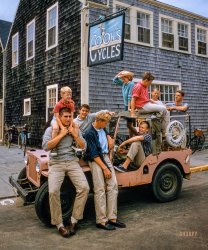
- Modern Dentistry: 1901
- ... find it entertaining, in fin de siècle photos, to see bicycles parked below the curb, as if they were either horses or motor ... point of view, what is the most striking about the way the bicycles are parked is that not one of them appears to be locked to anything. ... Posted by Dave - 02/07/2023 - 9:35am -
![Modern Dentistry: 1901 Washington, D.C., circa 1901. "View of F Street N.W., north side between 12th & 13th, showing various businesses." 5x7 inch glass negative, D.C. Street Survey Collection. View full size.
Narrow vertical display on rightOn the far right of the photo, to the right of the Schneider display window with the electrical fans, I see a tall vertical display of nine white squares with black figures on them. What in the world is that?
Egg salad sandwich and pieHow great to see Reeves being built. It remained, until at least the 1960s, a favorite of DC shoppers. I still remember my awe at how fast the restaurant would serve your order, seeming only seconds after it was taken by the server.
Wow, who does the woman with bicycle look like --Miss Gulch?
Parallel parkingI always find it entertaining, in fin de siècle photos, to see bicycles parked below the curb, as if they were either horses or motor vehicles, though this convention is not strictly observed here. I will also observe, with considerable amusement, that the woman parking her bike in front of the shoe store wasn't buying the hype about "bicycle face".
[They're parked they way they are (against curbs, lampposts, etc.) because there's no bike rack and they don't have kickstands. - Dave]
Reeves' counter revolutionThis photo captures a turning point in one of the longest-living restaurants in the District. What began around 1887 as a grocery store at 1209 F Street N.W. became Reeves in the late nineteenth century when Sewell Reeves took ownership. According to a history of District restaurants, "by 1902 he had enlarged the building with the bakery and candy departments occupying the second and third floors and the lunch counter lengthened to seat 150."
Known for that lunch counter, it would remain in place until the 1980s, reopening after a 1984 fire, until it was displaced from F to G Streets by redevelopment of this site.
The pie was strawberryReeves was on F Street well into the 1980s, closed for a bit and then reopened on G Street for a while. They were famous for their strawberry pie.
Remarkable bike parkingFrom the modern point of view, what is the most striking about the way the bicycles are parked is that not one of them appears to be locked to anything.
When apostrophes were used correctly.And periods were used indiscriminately.
(The Gallery, Bicycles, D.C., D.C. Street Survey, Stores & Markets)](https://www.shorpy.com/files/images/SHORPY-40280a.thumbnail.jpg)
- Speed Racer: 1925
- ...
[BSA -- Birmingham Small Arms, a British maker of bicycles and motorcycles. - Dave]
Other points of interest Note ... Small Arms, which began as a gun manufacturer, produced bicycles in the first half of the twentieth century. During WWII they made a ... Posted by Dave - 08/13/2013 - 3:34pm -
![Speed Racer: 1925 July 18, 1925. Laurel, Maryland. "R.J. O'Connor, inter-city championship bicycle races, Laurel Speedway." National Photo Co. glass negative. View full size.
He does."Who wears short shorts?"
BrakelessFixed gear -- no freewheeling. Great for fast track and stunt riding. Not so good for stopping. Get it wrong and over the handlebars you go.
FixieTrack racing bikes still have no brakes (and no freewheel device). The rider slows down by pedaling slower. They are still raced on wooden tracks, including in the Olympics. The tracks today are generally better finished and polished, since falls are common. Look at those huge splinters!
This fixed-geared arrangement has become very trendy lately, to the point it has a cutesy name: "fixie."
Handsome BrakelessAlso a handsome rake!
No Stopping HimYipes! There doesn't seem to be any braking mechanism on his bike. (Unless there is a foot brake that isn't apparent.) Also wondering what the sprocket lettering represents.
[BSA -- Birmingham Small Arms, a British maker of bicycles and motorcycles. - Dave]
Other points of interestNote the mold lines on the tires, and the axle hole through the crimped fork ends (rather than a slot).
HairodynamicAll that riding has sculpted his hair into a modern 2009 look!
BSABirmingham Small Arms, which began as a gun manufacturer, produced bicycles in the first half of the twentieth century. During WWII they made a folding bike for British Airborne paratroopers. After the war production switched to motorcycles, and in the 1950s and '60s "Beezers" were legendary racing bikes. They couldn't keep up with Japanese manufacturers, though, and by the early '70s the company was kaput.
Progress of another sortWhat housing block or shopping mall now covers the "Laurel Speedway"? Enquiring minds, etc.!
Fixie popularityWhen I was a courier in DC (89 to 97) only riders with major experience and major balls rode track bikes. It takes much more skill to stop quickly. Now every skinny jeans-wearing hipster rides a fixed gear bike, geared to stop easier and usually with a flat handlebar.
Of course a lot more people are riding bikes these days. Funny how all it took to get more people in this country to get back on bikes was super expensive gas and a serious recession.
Baltimore-Washington Speedwayhttp://www.wheelsofspeed.com/mdhist.html
Baltimore-Washington Speedway - Laurel, MD
1.125-mile wood oval (7/11/1925 - 9/25/1926)
The track, featuring turns banked at 48 degrees, was built by Jack Price in early 1925. The site is now the property of the Laurel Pines Country Club.
Stupid Bike TricksMy dad raced in San Jose in the 1930s. When I was a kid down on the central coast, he had a bike like this that he'd let us use. Long before it became fashionable to do crazy stunts on a bikes, we'd ride hell-bent for leather from the top of our street toward the beach. About halfway down, we'd stand up on the (absurdly skinny) seat. Usually we'd still hold onto the handlebars, but sometimes we'd stand all the way up for part of the ride and then jump back down to stop. It's amazing that any of us made it to adulthood.
I Agree WholeheartedlyDefinitely a handsome rake!
Pure rideI still have my track bikes from the 70's. Pure ride - who needs 20 gears? Back in the day, our jerseys and chamois were wool, we knew how to repair our own bikes, nailed our cleats on and rode because we loved to. And we laughed at those who spent a fortune on a bike and could not ride a straight line. Even more fun was zipping past some turkey on a road bike while on a track bike and doing it in the hills of the SF Bay Area.
(The Gallery, Bicycles, Natl Photo, Sports)](https://www.shorpy.com/files/images/14014u.thumbnail.jpg)























